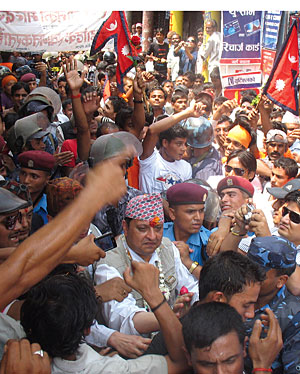 |
In the last few months, the former king has visited various Tarai towns, drawing significant numbers of people wherever he has been. It was similar when he travelled across Nepal five years ago. I remember him walking from Kupondole to Jawalakhel then. The streets were packed with people. Some addressed the monarch as 'sir', others as 'hajur'. Some asked for autographs, others offered flowers or shook his hand. Some chanted slogans, yet others were mere spectators. They represented a myriad of perspectives on the institution of monarchy.
Soon after, I travelled to Jumla and got to talking with some Maoist youngsters. They told me they had gone to Surkhet just to see "what the monarchy looked like" and some of them had even planned to throw cow dung at the king, but desisted. In contrast to rallies organised by political parties, it seemed as though those people who came to see the institution of monarchy did not do so on the basis of ideology or party membership. If that were so, then RPP (Nepal) would have reaped the benefits in the CA elections. This phenomenon tells us that at its base, the institution of monarchy is not political. More recently, however, these crowds appear to be motivated in part by the ideology of Hindutva. This could have a negative impact on the future of Nepali politics.
The present coalition is indifferent to the fact that it has ousted the monarchy and doesn't even consider engaging it as a cultural body to build a new Nepal. This alienating attitude has led the monarchy to seek refuge in potentially dangerous ideologies. Recall the recent visit by Kamal Thapa and Khum Bahadur Khadka to India, following which they declared that the Vishwa Hindu Parishad would�do anything to restore Nepal's monarchy.
The monarchy is first and foremost an institution that played a part in building the 'imagined community' called Nepal. Benedict Anderson says a nation 'is imagined because the members of even the smallest nation will never know most of their fellow-members, meet them, or even hear of them, yet in the minds of each lives the image of their communion'. We are Nepali because 250 years ago the monarchy brought together all ethnicities under the sphere of a sovereign Nepal. In the minds of the people, there is an affinity between being citizens of Nepal and the institution that created it. The turnout to see the former king indicates that the monarchy's embedded identity still exists. But it would be a terrible mistake to mistake this identity for a political force. It would be wiser to engage the monarchy culturally rather than alienate it and unleash an unpredictable political force.
This is all the more important given Indo-Nepal relations since 1947. India has always played a major role in the shifting of coalitions within Nepal, and has gained more than Nepal has from these historical transitions. Nepal's incumbent establishment has always neglected to engage outgoing or minor political forces. This failure has left Nepal vulnerable to alienated groups seeking the patronage of foreign powers. The institution of monarchy could be similarly used by Indian political forces.
The monarchy will most likely be left out of the belated constitution to come. The process of building a new nation requires all sections of society to be actively engaged and trusting of each other. In the making of a new Nepal, the monarchy should be given a cultural role to bring together different ethnicities, religions and ideologies, extending the message of unity. Such a cultural engagement would benefit the Nepali nation, and would also nullify the risk of a disgruntled monarchy being used by foreign powers.
The author is a Phd candidate in the political science department of Seoul National University.
READ ALSO:
Politics abhors a vacuum, Publisher's Note
Ready, steady, no?, Dewan Rai
Flex-ible, Prashant Jha
Full circle FM, CK Lal
United we fall, Indu Nepal
Just questions, Ashutosh Tiwari
Two seconds to midnight, Ass
Whither constitution writing



